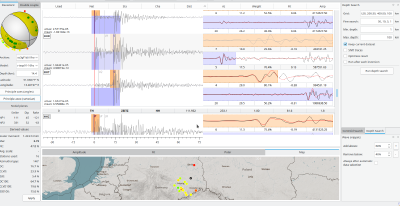Unexpected M3.2 earthquake hits Brandenburg/Germany on 10/18/2024: Location, moment tensor, ShakeMap
Nov 13, 2024
Categories:
Earthquake
On 18 October 2024 at 12:50 local time (10:50 UTC) an unexpected earthquake of magnitude 3.2 hit the Federal State of Brandenburg/Germany halfway between the small cities of Herzberg and Doberlug-Kirchhain. The event was clearly felt by people nearby and swiftly detected and located by SeisComP. A precise analysis of this event is important since seismicity is low and no comparable event is know in the region for the past 500 years.
This event highlights the capability of SeisComP and
gempa modules
for robust and rapid
detection and analysis of small earthquakes, providing valuable insights to
seismicity even in regions with sparse seismic networks.
We have automatically detected and processed the event in real-time using our
autonomous SeisComP system enhanced by
scanloc, ccloc and
sceval as the fundamental processing modules for monitoring
local earthquakes in a dedicated pipeline. The automatic system allowed the
initial detection and location only 26 seconds after the earthquake occurred.
A stable magnitude estimation of 3.2 was available after only 1 minute without
any dedicated tuning for rapid amplitude measurement.
We estimate the depth of the event to be near 14 km consistently by manual and automatic solutions. However, the monitoring network is sparse in the region and the closest station, station GR.CLL of the German Regional Seismic Network at Collm observatory , is still 50 km away. Therefore, the depth estimate has significant uncertainty but we find a source depth within 11 and 16 km reasonable from inversion of arrival times.
While all automatic solutions rely on data from stations institutionally operated, for manual processing a few RaspberryShake stations could be integrated resulting in an improved azimuthal coverage.
Initial focal mechanisms manually inferred from first-motion P-wave polarities are highly non-unique due to missing stations covering the focal sphere. An inversion of waveforms using our powerful and user-friendly scmtv for interactive moment-tensor inversion supports NW-SE normal faulting. The moment tensor has a vanishing isotropic but a large double-couple component. For inversion we used pre-computed Green’s functions sampled at 16 Hz and 3-component full waveforms windowed around P and S phases and filtered between 0.5 and 2 seconds period.
Using our SIGMA module, the calculated moment tensor and
GMPEs we have estimated the area within which the event was probably felt by
people. With SIGMA we have also computed relevant seismic
engineering parameters and compared observations with predictions by GMPEs for
identifying the most suitable GMPE for this region.








